Sulbactam/Durlobactam: Can a Branded, Targeted Antimicrobial for a Single, Resistant Pathogen Succeed?
In the October Editor-in-Chief letter, Jason Gallagher PharmD, FCCP, FIDP, FIDSA, BCPS, writes about this novel antibiotic indicated for a targeted, resistant pathogen and its long-term viability.

If you ask infectious diseases clinicians what new antibiotic they want to see, a “narrow-spectrum agent active against resistant gram-negative rods” (usually Pseudomonas) is a common reply. I admit that this is also one of my wants (along with an oral agent for multidrug-resistant [MDR] urinary tract infections). As of August, we finally have such an option. Sulbactam/ durlobactam (Xacduro), a combination of agents that is effective against MDR Acinetobacter baumannii and little else, just became available to clinicians. The next question is: Can this approach be commercially successful in our health care environment?
Though a narrow-spectrum antibiotic against a targeted, resistant pathogen seems like a wonderful tool to have, this approach has not been the way pharmaceutical companies have had previous success, particularly for gram-negative agents. Broad-spectrum agents that are safe and active against a variety of bacteria fulfill a much larger role in the market. When they have both broad-spectrum activity and utility for resistant pathogens, novel antibiotics fulfill the dual purpose that makes them attractive. This is a pathway of treatment escalation that we are used to. If your immunocompromised patient is septic and not improving on vancomycin and piperacillin/tazobactam, then try meropenem. If they’re still not better, then try ceftazidime/avibactam, etc. Although adding agents that are active against specific organisms of concern is certainly an empiric strategy that is used (eg, Candida, vancomycin-resistant enterococci), it is not as common as starting broad.
With sulbactam/durlobactam, we have an agent with essentially 1 use—carbapenem-resistant Acinetobacter baumannii (CRAB) infections—and one that is uncommon overall. The evidence supporting this use, the ATTACK trial (NCT03894046),1 is positive but not robust due to the limited study size. At a minimum, it is safer than polymyxins, a comparator that seems easy to beat but where others have stumbled. This small study was unable to show superior survivability for sulbactam/durlobactam, but the fact that numbers favored sulbactam/durlobactam gives hope that it may emerge as the drug of choice for CRAB with future study.
These data set the stage for my real question: What is the commercial viability of a targeted agent for a specific MDR infection? Estimates of the incidence of CRAB vary; a 2019 report from the CDC estimated 8500 cases and 700 deaths nationally,2 whereas a global assessment in The Lancet pegged the worldwide total at 57,700 deaths that year.3 Either way, CRAB is a deadly pathogen for which improved therapies are needed, and it seems it will take a significant percentage of cases receiving sulbactam/durlobactam for it to be commercially successful.
As for most antibiotics that address unmet needs, I am hoping for the success of sulbactam/ durlobactam. Every time a new antimicrobial is unsuccessful, it darkens the future for other agents by association as unattractive investments. Sulbactam/durlobactam fills a necessary role. If it fails, we will be forced to reevaluate the way we approach antimicrobial development.
References
1. Kaye KS, Shorr AF, Wunderink RG, et al. Efficacy and safety of sulbactam-durlobactam versus colistin for the treatment of patients with serious infections caused by Acinetobacter baumannii-calcoaceticus complex: a multicentre, randomised, active-controlled, phase 3, non-inferiority clinical trial (ATTACK). Lancet Infect Dis. 2023;23(9):1072-1084. doi:10.1016/S1473-3099(23)00184-6
2. Antibiotic Resistance Threats in the United States 2019. CDC. Accessed September 18, 2023. https://www.cdc.gov/drugresistance/pdf/threats-report/2019-ar-threats-report-508.pdf
3. Antimicrobial Resistance Collaborators. Global burden of bacterial antimicrobial resistance in 2019: a systematic analysis [published correction appears in Lancet. 2022 Oct 1;400(10358):1102]. Lancet. 2022;399(10325):629-655. doi:10.1016/S0140-6736(21)02724-0

Newsletter
Stay ahead of emerging infectious disease threats with expert insights and breaking research. Subscribe now to get updates delivered straight to your inbox.
